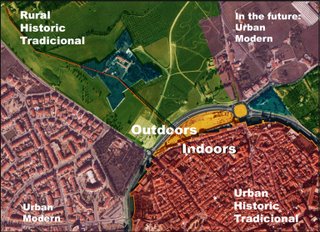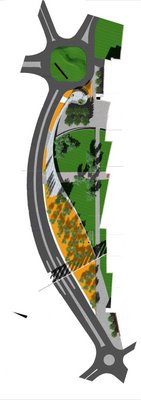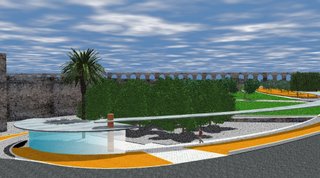The context and concept summary - Get in outdoors
Évora is situated in Alentejo, a southern region of the country, south of the river Tagus. Overlooking the whole landscape, there is Évora. It is called “the museum city” of Portugal and has been entitled as “World Heritage” by UNESCO.

 In the 20th century a serious problem was posed: the city developed beyond the Castle wall that surrounds the Historic centre, as a result of the growing country population flow. Illegal, badly designed neighbourhoods, with quite poor life quality, have mushroomed all around the city suburbs. The truth is that only the Historic centre has been valued. One must, however, ponder the fact that Évora cannot have been considered as “World Heritage” only due to the undeniable value of its patrimony, but also to the way that the culture of the city is influenced by its surrounding area. And that area, forgotten so far, should be taken into account from functional, visual and aesthetic points of view, as it is the first picture that any visitor gets of the city.
In the 20th century a serious problem was posed: the city developed beyond the Castle wall that surrounds the Historic centre, as a result of the growing country population flow. Illegal, badly designed neighbourhoods, with quite poor life quality, have mushroomed all around the city suburbs. The truth is that only the Historic centre has been valued. One must, however, ponder the fact that Évora cannot have been considered as “World Heritage” only due to the undeniable value of its patrimony, but also to the way that the culture of the city is influenced by its surrounding area. And that area, forgotten so far, should be taken into account from functional, visual and aesthetic points of view, as it is the first picture that any visitor gets of the city.


Évora is situated in Alentejo, a southern region of the country, south of the river Tagus. Overlooking the whole landscape, there is Évora. It is called “the museum city” of Portugal and has been entitled as “World Heritage” by UNESCO.

 In the 20th century a serious problem was posed: the city developed beyond the Castle wall that surrounds the Historic centre, as a result of the growing country population flow. Illegal, badly designed neighbourhoods, with quite poor life quality, have mushroomed all around the city suburbs. The truth is that only the Historic centre has been valued. One must, however, ponder the fact that Évora cannot have been considered as “World Heritage” only due to the undeniable value of its patrimony, but also to the way that the culture of the city is influenced by its surrounding area. And that area, forgotten so far, should be taken into account from functional, visual and aesthetic points of view, as it is the first picture that any visitor gets of the city.
In the 20th century a serious problem was posed: the city developed beyond the Castle wall that surrounds the Historic centre, as a result of the growing country population flow. Illegal, badly designed neighbourhoods, with quite poor life quality, have mushroomed all around the city suburbs. The truth is that only the Historic centre has been valued. One must, however, ponder the fact that Évora cannot have been considered as “World Heritage” only due to the undeniable value of its patrimony, but also to the way that the culture of the city is influenced by its surrounding area. And that area, forgotten so far, should be taken into account from functional, visual and aesthetic points of view, as it is the first picture that any visitor gets of the city.

The proposal area, adjoining the Castle wall, is crossed by the aqueduct and lies between two of the main entrances to the inner city: the so-called “Porta de Avis” and Porta de Alconchel”. At present it is used but as a car park and a passage.
This space is relevant as an area of reception and transition. It is an eclectic space, where different typologies and different aspects of space converge. Here, the traditional and the modern, the rural and the urban, the historic and the contemporaneous meet.


This proposal is also based on Eclecticism:
• it uses the existing potential;
• it finds a meaning and a meeting point for all the characteristics that converge here;
• it keeps the “Genius loci” if it affords it a new identity turned to the Future, in a city full of Past and Tradition.

Consequently, the basis of this project has focussed on the following assumptions:
• Bearing in mind that the Portuguese Garden derives from the Portuguese Recreation Farm (“Quinta de Recreio Portuguesa”), where leisure is always linked to production, the sustainability of the space is one of the main factors to take into account, favouring the local population in economic and cultural terms, using tradition and bringing in new activities at the same time. They are also plus factors to the visitors.

 It was thought important to make this space a link between the urban and the rural instead of a frontier, as it happens at present. The urban will keep developing outwards, but, regarding the present concept of “the city of the future” where the city and the countryside will never be set apart, we propose a little of the contrary: the rural development inwards.
It was thought important to make this space a link between the urban and the rural instead of a frontier, as it happens at present. The urban will keep developing outwards, but, regarding the present concept of “the city of the future” where the city and the countryside will never be set apart, we propose a little of the contrary: the rural development inwards.• Despite the focus that should be put on culture and tradition, we do not intend to “copy” the culture or the tradition of surrounding spaces, but rather innovate, using a more up-to-date and contemporaneous space language. To innovate through tradition.
• Taking into account that Évora is considered as “World Heritage”, it is extremely important that its “doors” are open to the world. As this space is the reception place of the “real world”, of the “outside world” into the mythical city inside the walls, we want to highlight and unveil Évora, turning it accessible to every visitor and making the understanding of this heritage easier through a more universal language.
This is the ideal place to receive the visitors to Évora, because it is a new space to meet existing needs and provide all the users -visitors and inhabitants- with new activities.
Get in outdoors!








1 comentário:
Parece-me espectacular. Dos mais criativos e geniais que tenho visto. É sem dúvida alguma uma forte referência a nível do panorama da arquitectura paisagista nacional.
João Marcos
Enviar um comentário